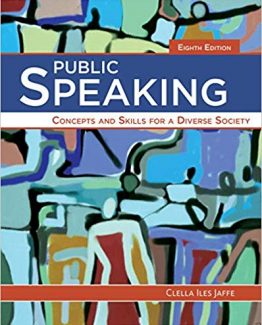Interpretation: Making a Difference on Purpose by Sam H. Ham, ISBN-13: 978-1555917425
[PDF eBook eTextbook]
- Publisher: Fulcrum Publishing (June 1, 2013)
- Language: English
- 320 pages
- ISBN-10: 1555917429
- ISBN-13: 978-1555917425
In the new edition of the international bestseller Environmental Interpretation, Sam H. Ham captures what has changed in our understanding of interpretation during the past two decades. Ham draws on recent advances in communication research to unveil a fresh and invigorating perspective that will lead interpreters to new and insightful pathways for making a difference on purpose through their work.
Table of Contents:
Foreword xi
Preface xv
Acknowledgments xxi
CHAPTER 1: Interpretation and Communication 1
Three Important Terms 3
A Working Definition of Interpretation 4
Interpretation versus Formal Instruction 8
Some of You Might Remember This Guy 9
Captive versus Noncaptive Audiences 11
The Interpretive Approach to Communication 14
From EROT to TORE 16
Glossary Terms 17
Additional Thoughts for Chapter 1 17
CHAPTER 2: TORE 19
Quality 1: Interpretation Has a Theme 20
Quality 2: Interpretation Is Organized 26
Quality 3: Interpretation Is Relevant 31
Quality 4: Interpretation Is Enjoyable 42
Where to from Here 48
Glossary Terms 49
Additional Thoughts for Chapter 2 49
CHAPTER 3: The Endgame of Interpretation 53
Some Possible Endgames of Interpretation 54
Interpretation as Provocation 56
Interpretation as Teaching 57
Interpretation as Entertainment 58
What Is “Excellence” in Interpretation? 60
So Which Endgame Is Best? 64
Glossary Terms 65
Additional Thoughts for Chapter 3 65
CHAPTER 4: Can All Interpretation Make Some Kind of Difference? 69
In Interpretation, TORE = Success 72
TRE, ORE, Tore, tORE, ToRe, tOrE, tore—You Get the Picture 74
Next Steps 76
Glossary Terms 77
Additional Thoughts for Chapter 4 77
CHAPTER 5: Making a Difference on Purpose 79
Difference 1—Interpretation Can Enhance Experiences 80
Difference 2—Interpretation Can Lead to Appreciative Attitudes 84
Difference 3—Interpretation Can Shape Behavior 88
The TORE Model 92
Summary and a Look Ahead 95
Glossary Terms 98
Additional Thoughts for Chapter 5 98
CHAPTER 6: Two Sides of Theme and Sentences in the Head 107
How Do You Describe What a Theme Is?—Intention versus Result 110
Sentences in the Head—One Theme Can Give Rise to Many 112
Where to from Here 119
Glossary Terms 119
Additional Thoughts for Chapter 6 119
CHAPTER 7: Not all Themes Are Equal 121
How Do You Know if a Theme Is Strong? 122
Ingredients of a Strong Theme 123
Some Ways to Strengthen a Theme 124
A Way to Add Interest to Difficult Themes 130
Tips for Strengthening a First-Draft Theme 134
What Themes are Not—Four FAQs 138
Summary and Where to from Here 143
Glossary Terms 144
Additional Thoughts for Chapter 7 144
CHAPTER 8: The Zone of Tolerance 149
How Wide Should a Zone of Tolerance Be? 152
Ethics in the Narrow Zone of Tolerance 163
Was Your Interpretation Successful?—Your Zone of Tolerance Tells You 166
Summary and a Look Ahead 168
Glossary Terms 168
Additional Thoughts for Chapter 8 168
CHAPTER 9: Sequential Theme Development 173
Sequential Theme Development 174
Sequential Communication Techniques 183
Three Models for Sequential Theme Development 188
Thematic Packaging 194
Summary and a Final Look Ahead 198
Glossary Terms 198
Additional Thoughts for Chapter 9 198
CHAPTER 10: Nonsequential Theme Development 205
What’s Different about Nonsequential Theme Development? 205
The Constraint of Time 206
A Strategy for Nonsequential Theme Development 209
Theme Titles versus Topic Titles 211
A Good Theme Title Provokes Thoughts within Your Zone of Tolerance 214
Summary 215
Glossary Terms 216
Additional Thoughts for Chapter 10 216
APPENDIX 1: Summaries of Two Key Theories behind the Tore Model of
Thematic Interpretation 219
APPENDIX 2: Verbs for Stronger Themes and More Engaging Commentaries 225
APPENDIX 3: Results of a Thought-Listing Procedure for a
“Theme-Title–Only” Message 235
APPENDIX 4: Captive versus Noncaptive Audiences—How the Idea Originated 243
Glossary of Key Terms 249
References 259
Subject Matter Index 279
About the Author 290
Sam H. Ham is a professor emeritus of communication psychology and conservation social sciences at the University of Idaho, USA. Sam’s work has taken him throughout the USA and Canada, and to nearly fifty other countries, where his approach to thematic communication is considered best practice in a wide variety of communication fields. Today, Sam’s thematic communication principles are put into daily practice by thousands of interpreters of cultural heritage and nature, as well as by museums, tour operators, zoos, botanical gardens, aquariums, national parks, and protected areas. Government bodies and private enterprises across the world have incorporated his theme-based principles into communication programs ranging from municipal sustainability and conservation education, to tourism marketing, philanthropy and interpretation of wine, beer, chocolate and art. His nearly 400 publications include the best-selling book, Environmental Interpretation—A Practical Guide for People with Big Ideas and Small Budgets, which was published in four languages. He also has edited six books on interpretation, storytelling and journalism for Fulcrum Publishing’s Applied
What makes us different?
• Instant Download
• Always Competitive Pricing
• 100% Privacy
• FREE Sample Available
• 24-7 LIVE Customer Support






Reviews
There are no reviews yet.